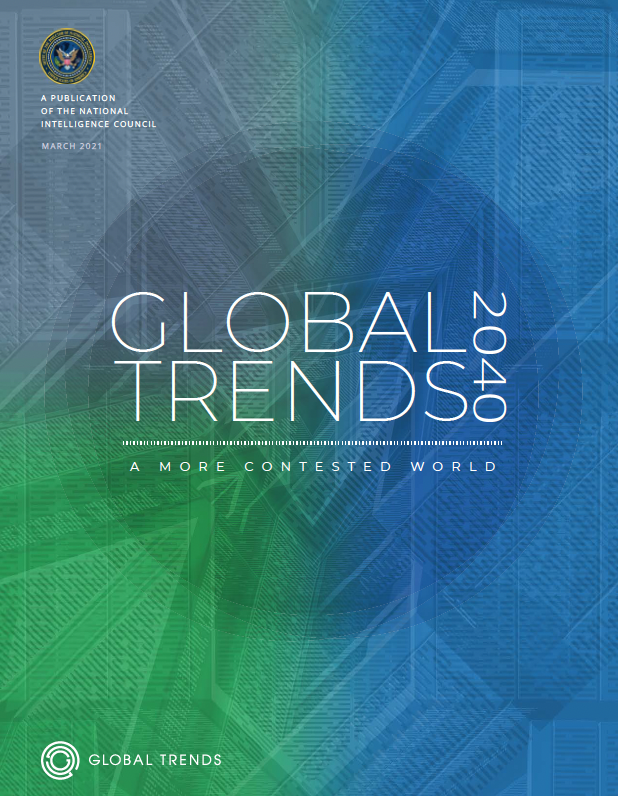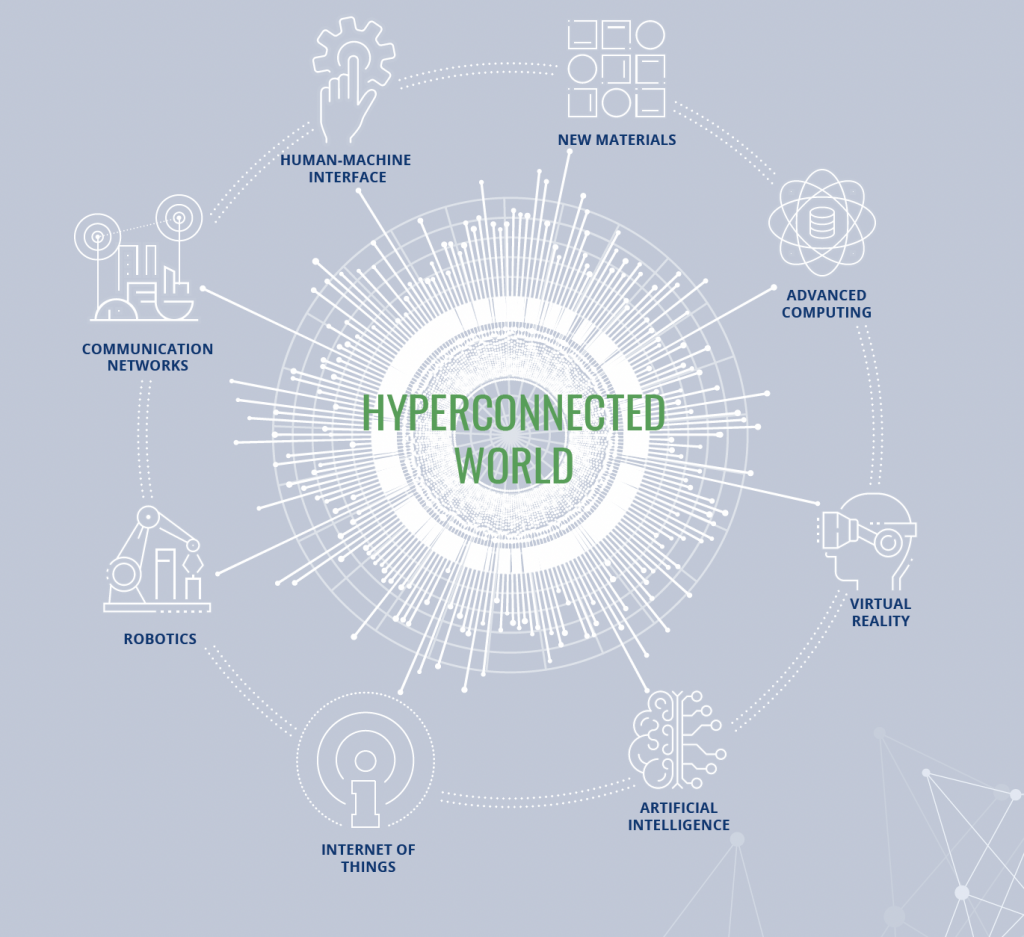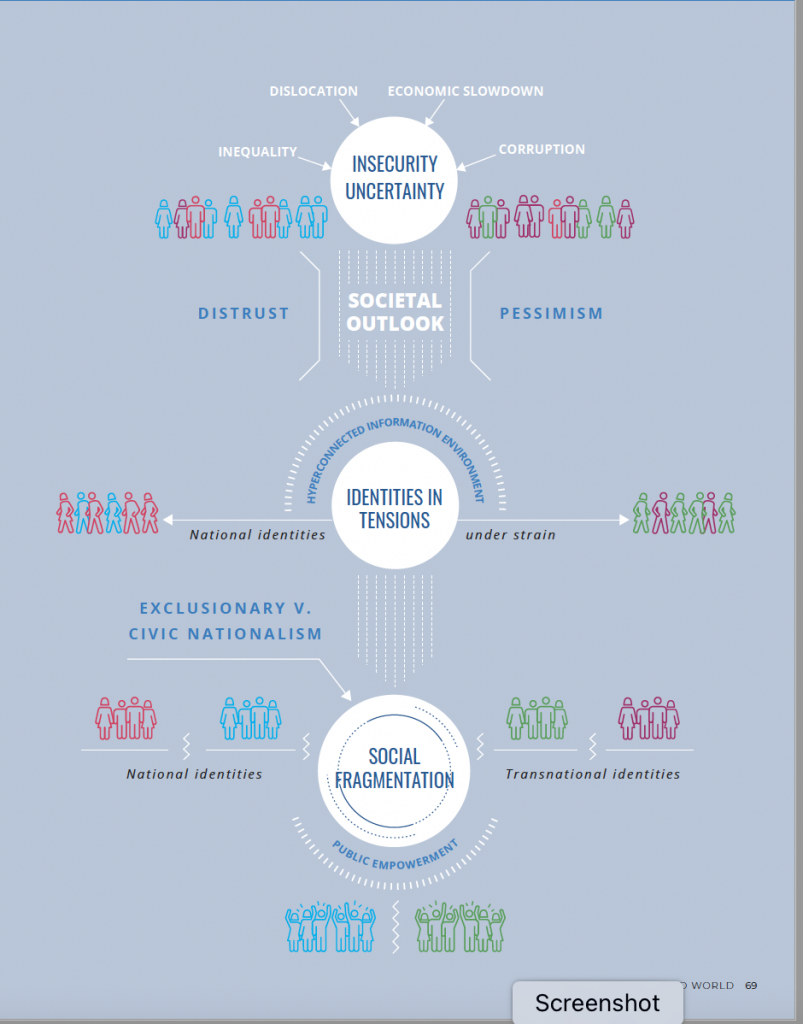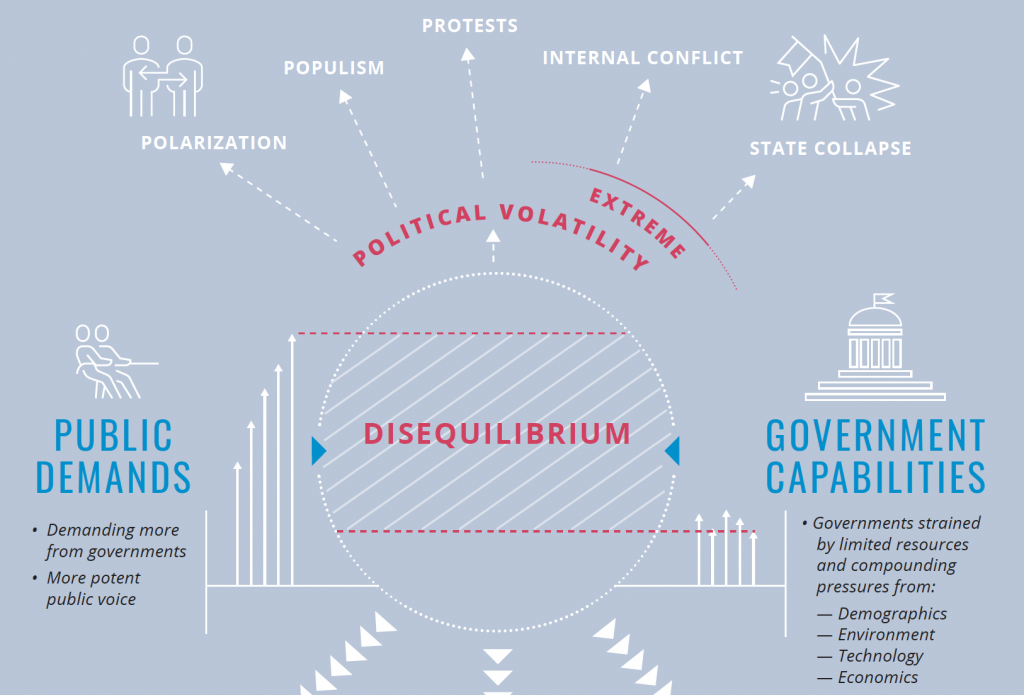I last posted to this site several months ago. Since then there have been several exceptional extreme weather events, and the publication of Climate Change 2021, the Sixth Assessment Report of the IPCC, which integrates projections of carbon emissions and Shared Socioeconomic Pathways (SSPs)- scenarios of the ways the world might change up to 2100. In addition a report by The National Intelligence Council of the United States, Global Trends 2040: A More Contested Future, outlines possible ways the world could change over the next two decades.
These two reports supplement and revise my previous posts about the future of places. In this post I summarize Global Trends 2040, and in the next post is a summary of the Shared Socioeconomic Pathways [SSPs] , and also recent extreme weather events. In each post I consider relevance for the future of places.

Global Trends 2040: A More Contested Future
Global Trends 2040 is a report for politicians and policy makers which assesses trends that might shape a range of possible futures. Although directed at American concerns, especially security, it provides a comprehensive perspective that is based on wide consultation with academics and others in Africa, Europe, and Asia. It has three main sections: structural forces, emerging dynamics, and scenarios of possible futures. As the subtitle suggests, its major theme is that proposals for change will be increasingly contested.
Structural forces are trends in demographics, environmental processes, economics and technology that provide a foundation for making projections about the future.
Demographically, population growth will slow but urbanization will increase. The report suggests that almost everywhere governments will struggle to meet the needs and expectations of more urban, educated, aging and connected populations.
Environmentally, climate change will impact every country and will be exacerbated by environmental degradation associated with poor land management, air pollution and water shortages. Emissions cuts to mitigate warming will be difficult because the pay-off runs counter to short-term political incentives. Furthermore, the uneven distribution of costs and benefits associated with reducing emissions and making adaptations is likely to increase political cleavages both within and between countries.
Economically, these cleavages could be compounded by disruptions associated with rising national debt, more complex trading conditions, the global spread of services that are delivered across borders, joblessness, and the continuing rise of very big business firms. All of these could have manifestations in everyday life in cities and their neighbourhoods.
Technologically, innovation will increase in pace and reach, it make for a hyperconnected world. This could help to mitigate the challenges of climate change, aging populations and economic upheaval. But it may also pose problems of security and privacy, and hyperconnectivity could result in “distortions of truth and reality that could destabilize societies at a rate that dwarfs current disinformation challenges.” Digital communications inform, yet confuse and divide communities.

Emerging dynamics are apparent in social and political shifts already underway, but whose outcomes are not easily projected. At individual and societal levels it seems people are becoming increasingly distrustful and pessimistic as they struggle to deal with disruptive economic, political, technological, and demographic trends. Information about these is increasingly available but it is often siloed as people retreat to like-minded groups. Some of those are rooted in places, and exclusionary, but others transcend borders, may be transnational and associated with a resurgence of cultural identities. Both will challenge civic minded attitudes and foster contestation, and at the international level could create more confrontational geopolitics.
A likely consequence of these emerging trends is that governments at all levels will face mounting pressure from economic constraints, aging populations, the costs of climate adaptation, and more empowered but fragmented communities. At all levels of government there could be a growing gap between popular expectations and what governments can deliver.

Five scenarios of the future are derived from the directions and uncertainties of forces and dynamics. The first three are based on various possible shifts in the international relationship between the US and China. The last two assume substantial global discontinuities.
Renaissance of Democracies – the US takes the lead in this. Democratic government provides better service provision, and restoration of public trust in institutions with strong differences of opinion resolved democratically.
A World Adrift – China takes the lead but is not dominant as the international system becomes directionless, there slow economic growth in developed countries following the Covid pandemic, and deepening social divisions and political paralysis. The costs and consequences of aging populations and repeated extreme climate events crowd out other initiatives, and promote political polarization. Climate change and instability in developing countries are largely unaddressed.
Competitive Coexistence – China and the US prosper and compete for leadership, strengthening economic interdependence, though long term stability remains at risk because climate change is ignored in favour of short-term economic gain.
Separate Silos – a world in which globalization has broken down because of cascading challenges of joblessness resulting from global trade, environmental deterioration and health problems, and in which nationalism and economic blocs emerge to provide protection from mounting threats through self-sufficiency.
Tragedy and Mobilization – bottom up revolutionary change in the wake of a global, devastating environmental crisis and the collapse of fisheries and food production. Political power is rechanneled to deal with immediate challenges and to promote sustainability. Countries dependent on fossil fuel are the slowest to adapt, while NGOs and multilateral organizations develop unprecedented ability to set standards and directions.
Implications for Places
Over the next 20 years particular places, by which I mean the neighbourhoods, towns, villages and regions where people spend most of their everyday lives, will mostly endure much as they are now in spite of globalization, economic booms and busts, hyperconnectivity, aging populations, and extreme weather events. Nevertheless Global Trends 2040 indicates that their could be substantial changes in the quality of life in them and their social/political character as public demands and government capabilities move in different directions.

Increasing urbanization in developing countries will pose challenges for provision of transportation, services and food unless there is substantial simultaneous economic growth. This suggests that quality of life in those urban places is likely to deteriorate and some of the gains made over the last few decades in eradicating deep poverty in them will be lost. In more developed countries the main concern is that age. Where a decline in the working age population is offset by immigration from less developed nations this will probably lead both to changes in the cultural character of places and to more racial discord.
The uneven distribution of the impacts of climate change, especially extreme events that cause disastrous damage in particular places but leave most others unscathed, will add a geographical dimension to political divisions, especially because it seems to be the case that less advantaged places are those that will suffer much of the damage. It also seems likely that the costs of mitigation and adaptation will be an increasing economic burden that will require trade-offs with other political priorities, such as the provision of affordable housing. that will be obvious in specific communities.
Of particular relevance for places is the suggestion that local governments and cities are likely to become more consequential because proximity and flexibility allows them to address problems that impact everyday life, including international issues such as climate change and immigration (see page 88). In other words, relatively local places will exercise increasing initiatives in dealing with problems that may be global in scope, and their attempts will be facilitated by digital connectivity. At the same time, local proposals for dealing with aging populations, climate adaptation and higher densities of urbanization, will be increasingly contested, partly because of nimbyism and partly because of the emergence of locally vociferous silos of disinformation.
If there is a revival of democracies, which currently seems unlikely, it would be manifest in revival of pride in place associated with processes for finding modest but acceptable approaches to adapting places to the diverse challenges that will emerge in the next two decades. If, however, the future is one of a world adrift, local places could become microcosms of the national and international discord.
Competitive coexistence seems to be an extension of how the Covid pandemic has been handled – a global problem addressed separately by individual nations, and in many cases by provinces or states within those nations, using different strategies to do the best for themselves. A common thread will be to put short-term economic gain above longer term social benefits, and this could easily result in things being worse off everywhere. In a future of Separate Silos places would be determined by ideas of exceptionalism, with local and regional fiefdoms doing their own thing regardless of broader consequences, where versions of nimbyism will be ascendent.
Tragedy and mobilization would means a very substantial shift of power and practice to the local level, because sustainability can only be successful through local initiatives that take into account regional, national and international patterns and processes. However the transition to this locally based but globally responsible awareness will involve profound upheavals and discord in everyday life in places as the character of jobs and businesses are changed, and as much political power shifts down from the level of the state to regions and municipalities.
Whichever scenario or combination of scenarios prevails over the next twenty years, it appears that everyday life in local places is going to become increasingly challenged as the effects of climate change and aging populations, which are currently in their initial phases, plus political discord, siloed views, and as deep disagreements about what should be done to address these and other challenges become more pronounced.